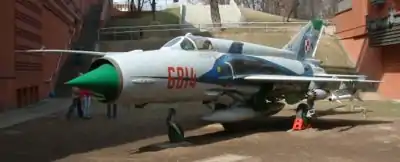Air enters a jet engine via the intake or inlet, which is a shaped duct connecting the streamtube (approaching the inlet) to the compressor face. A major objective is to lose as little total (or stagnation) pressure as possible in the process and to act as pre-compressor, whilst minimizing any distortion to the flow entering the compressor. Supersonic intakes often employ cones or ramps to create conical/oblique shock waves to help improve pressure recovery at supersonic flight speeds.
Functional requirements
Intakes are matched to the jet engine to provide maximum performance. This imposes different requirements on the intake depending upon the operating regime.
- Brake release: maximize mass flow by accelerating the static surrounding air without raising entropy.
- Takeoff & climb: Maximize pressure recovery while minimizing flow distortions due to off angle conditions
- Subsonic: maximize pressure recovery at speed and altitude
- Maneuver: Maximize mass throughput for given speed
- Supersonic: maximize pressure recovery at speed and altitude without suffering unstarts
- Hover (VTOL): Maximum mass flow with minimal hot gas reingestion
Pressure recovery
The incoming air flow is diffused. For subsonic flows a divergent duct is commonly used and for supersonic flows a convergent divergent duct is used. Supersonic intakes usually require movable structures to perform well. Without such measures lower performance results.
Distortion avoidance
The intake straightens the flow at high angles of attack and sideslip conditions. Using flow splitters, the low energy boundary layers next to fuselages can also be removed to provide uniform flow at the compressor face.
Noise suppression
Intakes usually have noise suppression surface treatments to reduce forward noise transmission.
EMF suppression
Compressor faces have a distinct dignature that can be suppressed by appropriately shaped screens, intake surface treatments and intake vanes.
Types
Pitot
A diverging forward facing duct is most often used. The length of the duct is governed by the flow straightening, boundary layer development and diffusion requirements.
3D compression (Conical centrebody)
For supersonic applications. Conical shockwaves from the central conical ramp are used to progressively compress the supersonic flow till a terminating normal shockwave makes the flow subsonic. From that shock wave onwards a divergent duct is used to diffuse the subsonic flow.

The cone can be moved depending upon the speed of operation although the cone angle cannot easily be changed.
2D compression (ramp)
A ramp is used to generate the inclined shockwaves to provide compression. The ramp angle is varied depending upon speed of operation. At low speeds the ramp can be oriented to provide minimal acceleration of the flow.
Components
Static surfaces
Guide vanes
Structure
Materials
Deicing
Noise suppression
Variable geometry
Ramps
Conical centrebodies
Vents
EMF treatments